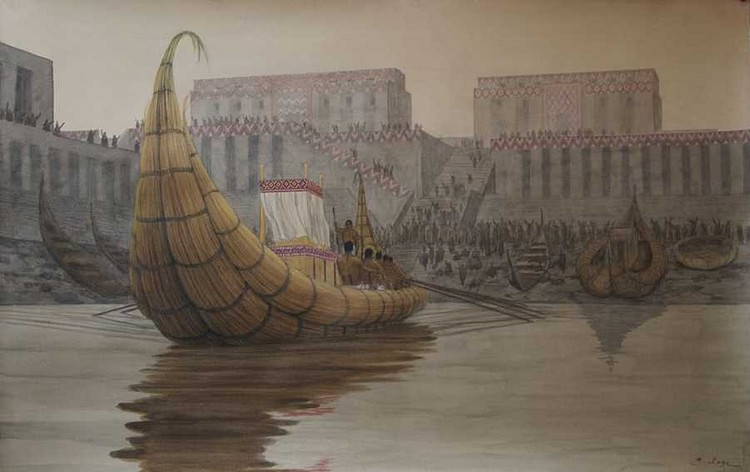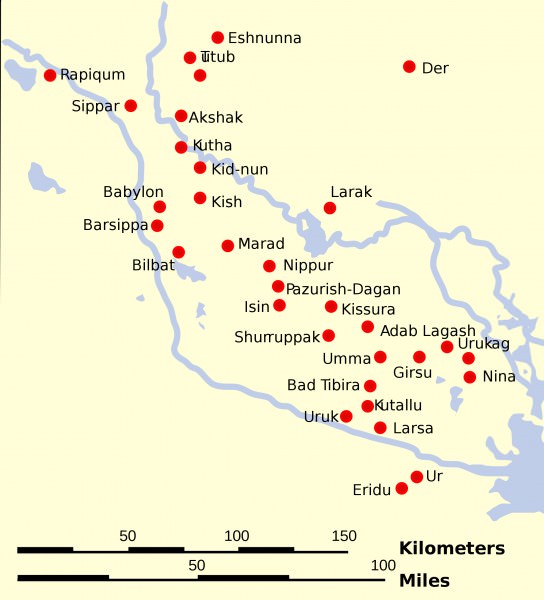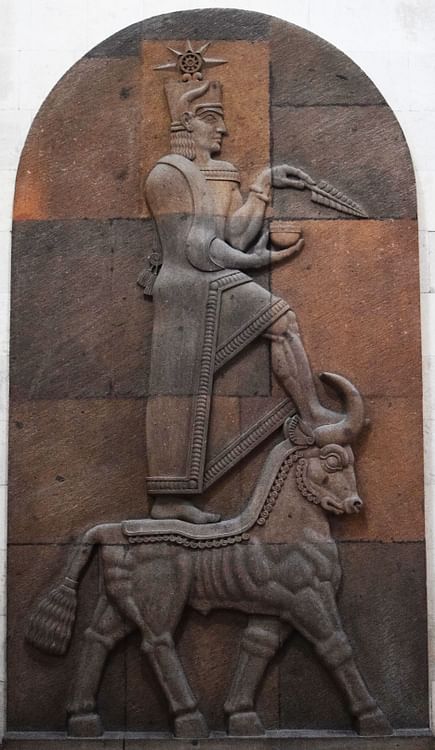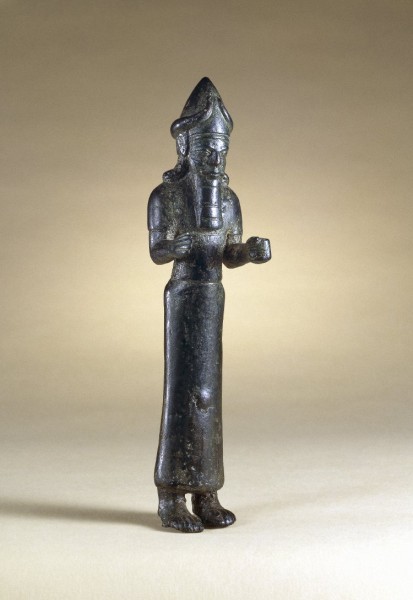Eridu › Urartu Religion » Ancient origins
Articles and Definitions › Contents
- Eridu › Antique Origins
- Urartu Religion › Antique Origins
Ancient civilizations › Historical and archaeological sites
Eridu › Antique Origins
Definition and Origins

Eridu (present day Abu Shahrein, Iraq) was considered the first city in the world by the ancient Sumerians and, certainly, is among the most ancient of ruins. Founded in circa 5400 BCE, Eridu was thought to have been created by the gods and was home to the great god Enki (also known as Ea) who would develop from a local god of fresh water into the god of wisdom and magic (among other attributes) and stand with other deities such as Anu, Enlil, and Inanna as the most important in the Mesopotamian Pantheon. The Sumerian King List cites Eridu as the “city of the first kings”, stating, “After the kingship descended from heaven, the kingship was in Eridu” and the city was looked back upon by the variouis tribes and city-states of Mesopotamia as a metropolis of a 'golden age' in the same way the writers of the biblical narratives created a ' Garden of Eden ' (most probably on the model of Eridu) as their mythical paradise from which humanity fell.
THE CITY OF ERIDU FEATURES PROMINENTLY IN SUMERIAN MYTHOLOGY, NOT ONLY AS THE FIRST CITY BUT ALSO AS THE HOME OF THE GODS.
The city of Eridu features prominently in Sumerian mythology, not only as the first city and home of the gods, but as the locale to which the goddess Innana traveled in order to receive the gifts of civilization which she then bestowed upon humanity from her home city of Uruk (considered by modern scholars to be the first city in the world). The Eridu Genesis (composed c. 2300 BCE) is the earliest description of the Great Flood, pre-dating the biblical book of Genesis, and is the tale of the good man Utnapishtim (also known as Atrahasis or Ziusudra) who builds a great boat by the will of the gods and gathers inside 'the seed of life'. The Eridu Genesis may have been the first written record of a long oral tradition of a time around 2800 BCE when the Euphrates rose high above her banks and flooded the region. Excavations at Ur by Leonard Wooley in 1922 CE revealed an eight-foot layer of silt and clay, consistent with the sediment of the Euphrates, which seemed to support the claim of a catastrophic flood in the area around 2800 BCE. Notes of the excavation taken by Wooley's assistant, Max Mallowan, however, showed the event was clearly a local, not a global, event.
A proto-Genesis tale of the Garden has been found at Eridu in which Tagtug the Weaver (or gardener) is cursed by Enki for eating of the fruit of the forbidden tree in the garden after being told not to. Eridu is further associated with the tale of the great sage Adapa (son of Enki), who was initiated into the meaning of life and all understanding by the god of wisdom but was ultimately tricked by him and denied the one thing he most wanted: knowledge of life without death, to live forever. The desire for immortality features prominently in Mesopotamian literature, and Sumerian writings specifically, and is epitomized in the story of Gilgamesh of Uruk. Uruk's link to Eridu is significant in that Eridu's initial importance was later eclipsed by the rise of the first city of Uruk. This transferrence of power and prestige has been seen by some scholars (the historians Samuel Noah Kramer and Paul Kriwaczek among them) as the beginnings of urbanization in Mesopotamia and a significant shift from the rural model of agrarian life to an urban-centered model. The story of Inanna and the God of Wisdom, in which the goddess of Uruk takes away the sacred meh (gifts of civilization) from Enki, the god of Eridu, can be seen as an ancient story symbolizing this shift in the paradigm of Sumerian culture.

Map of Sumer and Elam
MAP
Urartu Religion › Antique Origins
Definition and Origins

The religion of the Urartu civilization, which flourished principally in ancient Armenia from the 9th to 6th century BCE, was a unique mix of indigenous, Hurrian and Mesopotamian gods and symbolism. The pantheon was headed by the trinity of Haldi, Teisheba, and Shivini, who were the principal beneficiaries of sacrifices and temples built in their honour. Inscriptions, dedications and representations in art are all a testimony to the importance of religion in Urartu culture and especially to warfare.
THE URARTU PANTHEON
The gods of the Urartu religion were many, but they are handily listed in a 9th-century BCE inscription discovered in a niche in the mountains near the capital Tushpa (Van). The list, inscribed in duplicate, mentions 79 gods and the various sacrifices which should be made to each. The large number of deities may be explained by the fact that the Urartu religion adopted gods and practices from the Hurrians and other Mesopotamian cultures, which were mixed with indigenous Urartian gods. In addition, a feature of Urartu territorial expansion was the assimilation of local gods into the official pantheon of the conquerors.Many of these local gods were totems and represented such important elements or prominent natural features as water, earth, the sun, mountains, caves and trees. Still other deities were related to ancient animalistic beliefs.
ALL WARS WERE CARRIED OUT IN HALDI'S NAME, HIS BLESSING WAS SOUGHT BEFORE A CAMPAIGN & HE WAS GIVEN A REPORT OF IT AFTERWARDS.
The three most important Urartu gods were Haldi (Khaldi), god of war and the supreme deity, Teisheba, the god of storms and thunder who was likely based on the Hurrian god Teshub, and Shivini, the Sun god, who was often represented as a kneeling man holding a winged solar disk, and therefore likely inspired by the Egyptian god of the same association, Ra. Haldi's consort was Arubani (or Bagmashtu in the eastern part of Urartu, notably at Musasir/Ardini), the most important female goddess;Teisheba's consort was Huba (aka Khuba), and Shivini's was Tushpuea (aka Tushpues). The close cultural relations between Urartu and Assyria are again illustrated by the Urartian application of the Assyrian ideograms for the gods Adad and Shamsh to their own gods Teisheba and Shivani respectively.
Other important gods include Sielardi, the moon goddess, Epaninaue, the land goddess, Dsvininaue, a sea or water goddess, Babaninaue, the goddess of mountains, and Sardi, the star goddess. Most towns were given their own local god or goddess who was often named after the settlement, eg “the god of the town of Kumanu”. The most famous examples of such naming conventions were the capital Tushpa named after Tushpuea and the important city of Teishebaini, founded and named after Teisheba by king Rusa II (rc 685-645 BCE).
HALDI
Haldi had always been an important deity but it was the mid-9th century BCE king Ishpuini who promoted Haldi to the head of the gods. A deity of foreign origin, like the supreme god in many other ancient cultures, his role and function are obscure. We do know that he was closely associated with warfare and all wars were carried out in his name, his blessing was sought before a campaign, and he was given a report of it afterwards. Haldi also has more inscriptions dedicated to him than any other god.So important was this god that the Urartians were sometimes called the Haldians or “children of Haldi”. The ruling king was known as the “servant of Haldi” and many inscriptions end with the phrase “By the will of Haldi” ( Haldini ishmasini ).

Bas Relief of Haldi
Haldi had temples specifically built in his honour which have distinctive square towers with reinforced corners. As might be expected for the god of war, his temples were adorned with dedications in the form of weapons: swords, spears, bows and arrows, as wells as armour, helmets, and shields. Indeed, sometimes a temple of Haldi's is referred to as the “house of weapons”. One Assyrian inscription from the reign of Sargon II (722-705 BCE), who sacked Ardini in 714 BCE, lists in detail the mass of weaponry dedicated and stored at Haldi's temple there:
25,212 bronze shields, 1514 bronze javelins…and 305,412 swords…One large sword, a weapon worn at his waist…of gold ; 96 silver javelins…silver bows and silver spears, inlaid with gold and mounted; 12 heavy shields…33 silver chariots. (quoted in Chahin, 140)
In addition, even during peacetime Haldi remained prominent in the minds of the Urartians, and all public works such as roads, canals and palaces were built in his name.
RELIGIOUS ARCHITECTURE
Temples were constructed, as already noted, and, although none survive, some of their details may be gleaned from external sources such as contemporary Assyrian reliefs. One such relief is from the palace of the Assyrian king Sargon II which shows the temple of Haldi at Ardini before it was sacked in 714 BCE. The building stands on a high platform and has a hexastyle portico (six-columned facade) and triangular pediment. The pitched roof carries a spear ornament, and shields hang from the exterior walls. A great urn stands either side of the entrance. Not only temples but fortresses, too, were associated with particular gods, for example, two fortresses around Lake Sevan were known as “the fortress of the god Haldi” and “the fortress of the god Teisheba”.
TEMPLES, WITH THEIR OWN AGRICULTURAL LANDS, WERE AN IMPORTANT ELEMENT OF THE COMMUNITY AND THE ECONOMY.
Temples, with their own agricultural lands, were an important element of the community and the economy. They were also a method to impose cultural as well as political dominance over subject peoples. As already mentioned, some foreign gods were imported into the Urartu pantheon but conversely, and especially in the less advanced northern territories which were regarded as “barbaric” compared to eastern cultures, the Urartian kings did impose their own gods. Rusa II, for example, built a temple to the storm god Teisheba in the newly conquered Sevan area.
OFFERINGS, SACRIFICES & BURIALS
Ceremonies and rituals to honour the gods were held in dedicated outdoor ritual spaces with low surrounding walls, the temples described above, and at false doorways carved into rock faces which were known as “Gates to the Gods”. Animals were sacrificed to honour the gods, typically bulls, cows, goats, and sheep. Other offerings included food, weapons, and precious goods, as well as libations of wine.

Urartean Male God Figurine
The Urartu royalty and elite were buried in tombs, usually cut into rock promontories. At the capital Tushpa, there is a royal necropolis composed of chambers cut into the mountain on which the city was built. Similar examples can be found at fortress sites. Tombs are composed of single, double, or triple chambers with the tomb entrance sealed by a large stone slab. Several royal tombs, long since looted, still carry inscriptions which describe the deeds and campaigns of the ruler in question. Of those tombs discovered intact, several contain stone sarcophagi with semicircular lids. Buried with the deceased were precious goods, weapons, shields, and even furniture, a practice which suggests the Urartians believed in an afterlife and that it was similar enough to the earthly one to necessitate such provisions.
RELIGIOUS ART
Religious art includes bronze figurines of prominent gods such as Haldi, Teisheba, and Shivini. Haldi is often portrayed as a man, with or without a beard, standing on a lion, symbolic of his courage, power, and virility. In contrast, Teisheba is shown standing on a bull and holding thunderbolts in his hands. Some figurines of deities are unidentified such as a female goddess rendered in bone, and there are, too, strange hybrid figures of a fish-man, bird-man, and scorpion-man. These latter creatures, frequently painted on storeroom interior walls, were likely regarded as protective spirits. Large bronze cauldrons were produced in significant numbers, and their rims are often decorated with the heads of winged female goddesses, perhaps representations of Tushpuea. Processions of gods are sometimes depicted in the wall paintings too. Finally, as perhaps is to be expected for a war god, Haldi is frequently represented on engraved weapons, belts, shields, and medallions.
This article was made possible with generous support from the National Association for Armenian Studies and Researchand the Knights of Vartan Fund for Armenian Studies.
LICENSE:
Article based on information obtained from these sources:with permission from the Website Ancient History Encyclopedia
Content is available under License Creative Commons: Attribution-NonCommercial-ShareAlike 3.0 Unported. CC-BY-NC-SA License